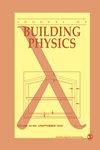Definition, estimation and decoupling of the overall uncertainty of the outdoor air temperature measurement surrounding a building envelope
IF 1.4
4区 工程技术
Q3 CONSTRUCTION & BUILDING TECHNOLOGY
引用次数: 0
Abstract
Outdoor air temperature represents a fundamental physical variable that needs to be considered when characterising the energy behaviour of buildings and its subsystems. Research, for both simulation and monitoring, usually assumes that the outdoor air temperature is homogeneous around the building envelope, and when measured, it is common to have a unique measurement representing this hypothetical homogeneous outdoor air temperature. Furthermore, the uncertainty associated with this measurement (when given by the research study) is normally limited to the accuracy of the sensor given by the manufacturer. This research aims to define and quantify the overall uncertainty of this hypothetical homogeneous outdoor air temperature measurement. It is well known that there is considerable variability in outdoor air temperature around the building and measurements are dependent on the physical location of outdoor air temperature sensors. In this research work, this existing spatial variability has been defined as a random error of the hypothetical homogeneous outdoor air temperature measurement, which in turn has been defined as the average temperature of several sensors located randomly around the building envelope. Then, some of these random error sources which induce spatial variability would be the cardinal orientation of the sensor, the incidence of solar radiation, the outdoor air temperature stratification, the speed and variations of the wind and the shadows of neighbouring elements, among others. In addition, the uncertainty associated with the systematic errors of this hypothetical homogeneous outdoor air temperature measurement has been defined as the Temperature Sensor Uncertainty [Formula: see text] where this uncertainty is associated with the sensor’s accuracy. Based on these hypotheses, a detailed statistical procedure has been developed to estimate the overall Temperature Uncertainty [Formula: see text]) of this hypothetical homogeneous outdoor air temperature measurement and the Temperature Sensor Uncertainty [Formula: see text]. Finally, an uncertainty decoupling method has also been developed that permits the uncertainty associated with random errors (Temperature’s Spatial Uncertainty [Formula: see text]) to be estimated, based on [Formula: see text] and [Formula: see text] values. The method has been implemented for measuring the outdoor air temperature surrounding an in-use tertiary building envelope, for which an exterior monitoring system has been designed and randomly installed. The results show that the overall Temperature Uncertainty [Formula: see text] for the whole monitored period is equal to ±2.22°C. The most notable result is that the uncertainty associated with random errors of measurement (Temperature’s Spatial Uncertainty [Formula: see text]) represents more than 99% of the overall uncertainty; while the Temperature Sensor Uncertainty [Formula: see text], which is the one commonly used as the overall uncertainty for the outdoor air temperature measurements, represents less than 1%.建筑围护结构周围室外空气温度测量总体不确定性的定义、估算和解耦
室外空气温度是描述建筑物及其子系统能源行为时需要考虑的一个基本物理变量。无论是模拟还是监测研究,通常都会假定建筑物围护结构周围的室外空气温度是均匀的。此外,与该测量值相关的不确定性(由研究提供)通常仅限于制造商提供的传感器精度。本研究旨在定义和量化这种假定均质室外空气温度测量的总体不确定性。众所周知,建筑物周围的室外空气温度变化很大,测量结果取决于室外空气温度传感器的实际位置。在这项研究工作中,现有的空间变异性被定义为假定的均匀室外空气温度测量的随机误差,而室外空气温度测量又被定义为随机分布在建筑物外围的多个传感器的平均温度。导致空间变化的一些随机误差源包括传感器的中心方位、太阳辐射入射、室外空气温度分层、风速和变化以及邻近元素的阴影等。此外,与这种假设的同质室外空气温度测量的系统误差有关的不确定性被定义为温度传感器的不确定性[公式:见正文],这种不确定性与传感器的精度有关。根据这些假设,制定了详细的统计程序,以估算该假设同质室外空气温度测量的总体温度不确定度[公式:见正文]和温度传感器不确定度[公式:见正文]。最后,还开发了一种不确定性解耦方法,可根据[公式:见正文]和[公式:见正文]值估算与随机误差相关的不确定性(温度的空间不确定性[公式:见正文])。该方法用于测量在用三级建筑围护结构周围的室外空气温度,为此设计并随机安装了室外监测系统。结果表明,整个监测期间的总体温度不确定性[公式:见正文]等于±2.22°C。最显著的结果是,与随机测量误差相关的不确定性(温度的空间不确定性[计算公式:见正文])占总体不确定性的 99% 以上;而温度传感器不确定性[计算公式:见正文],即通常用作室外空气温度测量的总体不确定性,则占不到 1%。
本文章由计算机程序翻译,如有差异,请以英文原文为准。
求助全文
约1分钟内获得全文
求助全文
来源期刊

Journal of Building Physics
工程技术-结构与建筑技术
CiteScore
5.10
自引率
15.00%
发文量
10
审稿时长
5.3 months
期刊介绍:
Journal of Building Physics (J. Bldg. Phys) is an international, peer-reviewed journal that publishes a high quality research and state of the art “integrated” papers to promote scientifically thorough advancement of all the areas of non-structural performance of a building and particularly in heat, air, moisture transfer.
 求助内容:
求助内容: 应助结果提醒方式:
应助结果提醒方式:


